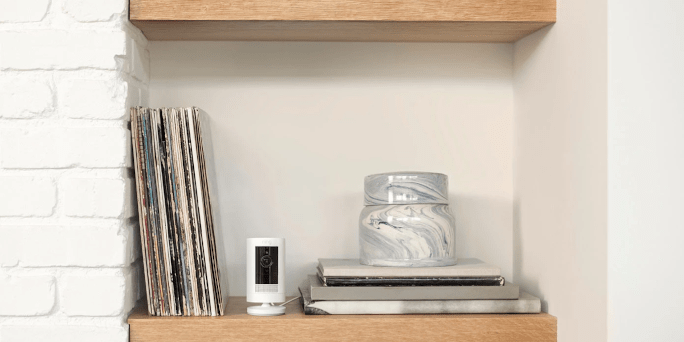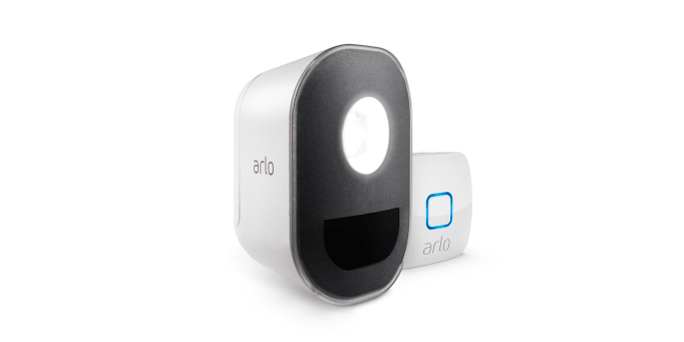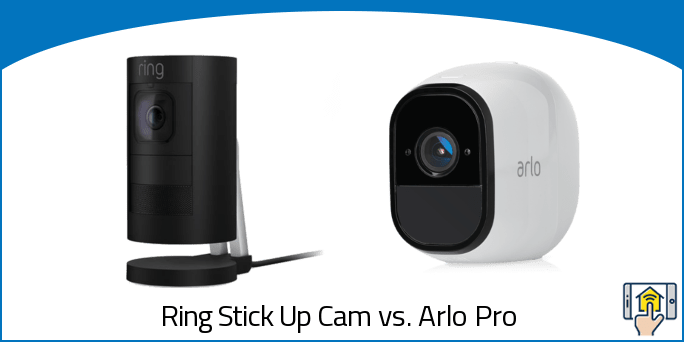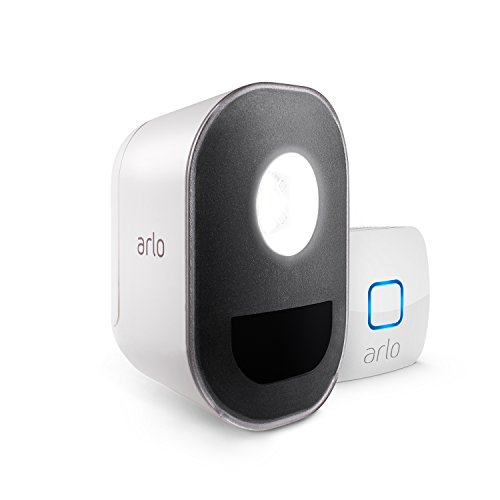Ring and Arlo both offer a variety of video solutions at different price points, and as time goes on they have continued to improve upon their existing lineup. The All-New Ring Stick Up Cam comes in four options: , , , and Elite. The Ring Stick Up Cam Battery, Plug-in, and Solar are Gen 3 cameras, whereas the Ring Stick Up Cam Elite is rebranded Gen 2 Ring Stick Up Cam Wired.
The Arlo Pro, on the other hand, is the company’s mid-range offering — falling right in between the Arlo and Arlo Pro 2 cameras.
When comparing the Ring Stick Up Cam vs. Arlo Pro, it’s difficult to give a clear answer as to which camera is “best,” as they excel in different areas. For example, Arlo offers great features like video recording without a subscription, while Ring has better video quality and functions without a base station. Our top pick is the Ring Stick Up Cam Elite, but there are arguments to be made for both brands.
Below we go into detail on what each option has to offer to help give you a sense of which camera might be best for your home. However, feel free to use the navigation bar to jump directly to the sections that interest you most.
All-New Ring Stick Up Cam vs. Arlo Pro — Things in Common
-
On-Demand Live View – When you buy a Ring Stick Up Cam or Arlo Pro, you can access a live video feed from the smartphone app at any time — no subscription needed.
-
Digital Zoom – Sometimes the default camera view just isn’t enough. If you need some extra attention to detail, you can take advantage of the digital zoom on both devices.
-
Two-Way Audio – One of the coolest features of these cameras is their support for two-way audio. It’s perfect for yelling at that notorious thief that keeps nicking your packages or even just telling your cat to get off the counter.
-
Night Vision – There’s no reason that your video coverage needs to stop when the sun goes down. Both the Ring Stick Up Cam and Arlo Pro support night vision with 850 nm LEDs that illuminate up to 25 feet, and include an IR cut-off filter for better picture quality.
-
App Support – Regardless of your choice in brand, you’ll have access to complete control over your cameras through an Android, iOS, or Web app.
-
Weather-Resistant – While some companies have separate models for both inside and out, the Arlo Pro and Ring Stick Up Cams are weather-resistant and can be used wherever you please. Outfit your backyard and your living room with high-quality video monitoring without having to juggle different model numbers or brands.
-
IFTTT & Stringify – Last, but most definitely not least, both the Ring Stick Up Cam and Arlo Pro support IFTTT and Stringify. These incredibly powerful conditional trigger platforms allow your camera to integrate with other smart products like lights, locks, or even thermostats. The possibilities for customization are nearly endless, and both Arlo and Ring cameras are a great complement or starting point for a smart home.
All-New Ring Stick Up Cam vs. Arlo Pro — Differences

-
Difference #1: Power Options – Each of these cameras has their own approach to powering the camera.
The Ring Stick Up Cam Elite is our favorite as far as power options go, since it has the options for both Micro-USB AC Plug and Power over Ethernet (PoE). PoE provides an internet connection and power to the camera in just one cord, which can be a major perk for those of us in apartments or homes with a limited amount of space. You can technically hook up your Stick Up Cam to the internet with WiFi, but we’re big fans of Ethernet connections for our cameras since they provide a faster and more reliable connection.
The Ring Stick Up Cam Battery/Plug-In/Solar, as the name suggests, can use a rechargeable battery with a 3-6 month capacity, a Micro USB cable, or a solar panel for power. So, if you buy the Ring Stick Up Cam Solar, it’ll come with a Solar Panel to charge it using the power of the sun so that you never have to worry about plugging it in to charge. However, you can always switch to alternative power sources by using a rechargeable battery or a Micro USB cable.
The Arlo Pro also has a rechargeable battery with a 3-6 month life and its own Solar Panel. And, it also gives you the option to use an AC Plug — giving you the best of both worlds.
Our top pick from a power standpoint is definitely the Elite model of the Ring Stick up Cam due to how great PoE is, followed closely by the very flexible Ring Stick Up Cam Gen 3 and Arlo Pro.
-
Difference #2: Video Quality – One of the biggest differences when comparing the Arlo Pro vs. Ring Stick Up Cam is that all Ring Stick Up Cam models have superior video quality. With 1080p quality recorded at 30 FPS, you’ll have a crystal clear picture of any goings on in your home. The Arlo Pro only records in 720p, which can cause some problems when trying to identify intruders.
One thing that both brands share, however, is H.264 motion-compensation-based video compression, which allows most home networks to support up to four cameras without any drops in speed.
So, regardless of your choice you shouldn’t really see a hit to your connection. In terms of video quality, however, Ring is clearly the superior choice.
-
Difference #3: Field of View – Field of View is sort of a close competition between the two brands, although Arlo’s choice of metrics sort of obscures its true value.
The Ring Stick Up Cam Elite has a 150 degree horizontal and 85 degree vertical field of view, and the rest of Ring Stick Up Cams feature a 110 degree horizontal and 57 degree vertical field of view.
As for the Arlo Pro, it lists the field of view as 110 degrees diagonal, which at face value makes it seem like it’s much better than the Ring Stick Up Cam models. However, when you convert the Ring camera into a diagonal field of view rather than horizontal and vertical, it actually comes in at 130 degrees — making it slightly better than Arlo.
A lot of times, companies will use marketing tactics to put their products in the best possible light. Here, at Homejell, we do our best to cut through the smoke and mirrors and give you a straight answer.
So, long story short, both Ring Stick Up Cam Elite offers the best field of view, with Ring Stick Up Cam Battery/Plug-in/Solar taking the number two spot, and Arlo Pro having the worse coverage in this cameras comparison.
-
Difference #4: WiFi – One advantage that the Ring Stick Up Cam Elite has over the Ring Stick Up Cam Battery/Plug-in/Solar model and the Arlo Pro is the fact that it supports dual band connections. The support for 2.4GHz & 5GHz frequencies allows your camera to transmit more data without putting as much pressure on the network, which may be needed for homes that have a large number of cameras to balance.
The Arlo Pro and Stick Up Cam Battery/Plug-in/Solar only support 2.4GHz WiFi, which could potentially cause some congestion issues on heavily-trafficked networks.
-
Difference #5: Motion Detection – Motion detection is a key part of any quality smart camera, as it’s the main way that you’ll receive alerts to keep an eye on any suspicious activity. After all, who has the time to sit around all day and stare at a live feed?
The Ring Stick up Cam Elite offers advanced motion detection with custom zones and person detection. The Ring Stick Up Cam Battery/Plug-in/Solar is a little bit less impressive with standard motion detection, custom area zones, and no support for person detection.
Arlo Pro definitely falls behind the other two with a 23-foot motion detection range, no support for motion zones, and person detection that is locked behind a subscription.
Ultimately, from a tech standpoint, it’s difficult to beat the Ring Stick Up Cam Elite when it comes to keeping your home protected.
-
Difference #6: Requires a Base Station – All Ring Stick Up Cams function as is — straight out of the box and with no requirements for additional equipment. The Arlo Pro, on the other hand, requires a base station to function.
The base station plugs into your router and helps out your cameras by providing long range connectivity and better battery life for your cameras, and you can connect up to 15 cameras to a single station. While the extra range and battery life is nice, the fact remains that it’s an extra piece of equipment that you have to purchase.
The bright side is that for average-sized homes, you’ll only need one base to cover your entire home with Arlo equipment. Check out our take on the Arlo vs. Arlo Pro Base Station for a breakdown on the differences between your different hub options.
-
Difference #7: Siren – The siren is an important part of any home security solution — cameras included — and the two brands differ in how they implement the feature.
With the Ring Stick Up Cams, a 110 dB siren is built directly into the camera itself. With the Arlo Pro, on the other hand, the siren is located on the base station.
There are advantages and drawbacks to each implementation. Having a siren built into a Ring Camera on the outside of your home will do a great job of alerting your neighbors to intruders, which could be extremely helpful in an emergency situation or when you’re away from home. However, having the siren tied to the video equipment makes it easy to locate it at a glance, which could lead intruders to smash your cameras. Since footage is uploaded directly to the cloud, you’ll still have access to the evidence. That doesn’t help defray the costs of a broken camera, though, does it?
We don’t really feel that there’s a clear winner here. It’s going to depend on whether you value a more widespread alarm or better protected cameras.
-
Difference #8: Local Backup Storage – One cool perk of the Arlo system is its ability to store video footage to local backup storage as well as the cloud. Ring’s cameras are limited to uploading footage to the cloud, which means that you could end up with lost evidence if your internet goes down.
While physical storage connected to the Arlo Pro Base Station can’t be the sole option for storage and you’ll have to use cloud services to enable any sort of recording feature, it’s extra useful to have on hand in the event of a network outage. Plus, your Arlo app will inform you when your local storage is getting full and even start to automatically overwrite the older footage when it runs out of space!
While having to buy the Arlo Pro base station is an extra expense and that can be frustrating, it does give you access to some cool features like the local storage that just aren’t possible with Ring.
-
Difference #9: Record Live View – While both brands do allow you to view a live video feed at any time completely free of charge, only Arlo Pro allows you to record live view videos without a subscription. Ring video monitoring subscriptions aren’t very expensive so it’s not the end of the world, but we’re always big fan of extra functionality included for free.
-
Difference #10: Subscription – The Ring Stick Up Cam and Arlo Pro cameras both offer an optional subscription that adds some extra perks to your video monitoring.
Ring subscriptions are broken down into two different options: Ring Protect Basic and Ring Protect Plus.
The Basic plan activates video recording and sharing, as well as storage for up to 60 days for a single individual ring doorbell or camera. These plans start at just $3 a month, so they’re an excellent option for homeowners with just a couple of cameras that they’d like to equip with the ability to record.
Ring Protect Plus gives you all of those features on an unlimited number of cameras for $10 per month, as well as the 24/7 professional monitoring with cellular backup if you’ve opted to purchase the Ring Alarm security system. It’s a great value as is if you have more than a few cameras to monitor, but the value is even further amplified if you’ve outfitted your house with the motion detectors and sensors of the brand’s security system.
Arlo Pro cameras come with 7 days of cloud recording for up to 5 feeds by default for no extra charge, but they also offer a plan called Arlo Smart that adds in some extra features.
Arlo Smart adds person detection that will inform you when your camera senses human activity with a notification within the app, as well as cloud activity zones to further customize your camera’s motion detection. Other security features enabled by this subscription include Rich Notifications that allow you to take immediate action like activating a siren, calling a friend, or calling emergency services without even having to unlock your phone, and e911 Emergency Call Service that can feed emergency dispatchers the location of your home rather than tracking your phone which could be miles away from the crisis.
Arlo Smart is available as an add-on for $2.99 per month per camera. Alternatively, you can pay $9.99 per month for Arlo Smart Premier for all of the above as well as 30 days of cloud storage and support for up to 10 cameras, or Arlo Smart Elite at $14.99 per month for 60 days of storage and support for 20 cameras.
Ultimately, at the entry level the two brands are pretty similar. However, if you’d like to outfit your home with a large number of cameras, Ring is cheaper since you just pay a flat $9.99 for as many cameras as you please. With that said, Arlo’s subscription adds in some unique features like the Rich Notifications and e911 Emergency Call Service that may add enough value to warrant the expense. It’s really going to depend on what you value most in a security system.
-
Difference #11: Voice Control – All three of the cameras support Amazon Alexa and work particularly well with Echo Show 5 (Just keep in mind that you can’t use two-way audio through the Echo Show/Spot).
Arlo Pro is a little bit more impressive when it comes to voice control, however, with additional support for Google Assistant. Since Ring is owned by Amazon, it makes sense that they wouldn’t support a direct competitor, but it’s still disappointing for fans of the Google Home ecosystem.
All-New Ring Stick Up Cam vs. Arlo Pro — Comparison Chart
| Ring Stick Up Cam Elite | Arlo Pro | ||
|---|---|---|---|
| Video resolution | 1080p HD | 1080p HD | 720p |
| Frames per Second | 30 FPS | 30 FPS | 30 FPS |
| Video Format | H.264 | H.264 | H.264 |
| On-Demand Live View | Yes | Yes | Yes |
| Record Live View | Subscription Required | Subscription Required | Yes |
| Field of View | 150° horizontal, 85° vertical |
110° horizontal, 57° vertical |
110° |
| Zoom | Yes | Yes | 8x digital zoom |
| Power | Micro-USB AC Plug or PoE | Battery/Plug-In/Solar | Rechargeable Battery/AC |
| Optional Power Source | No | Solar Panel | Solar Panel |
| Battery Life | N/A | Battery: 3-6 months Solar: indefinitely |
Battery: 3-6 months Solar: indefinitely |
| Two-Way Audio | Yes | Yes | Yes |
| Motion Detection | Advanced | Standard | Up to 23 feet |
| Motion Zones | Custom, up to 6 | Areas | No |
| Person Detection | Yes | No | With Subscription |
| Facial Recognition | No | No | No |
| Sound Detection | Yes | Yes | Yes |
| Night Vision | Yes | Yes | Yes |
| WiFi | 2.4 GHz & 5 GHz | 2.4 GHz | 2.4 GHz |
| Requires a Base Station | No | No | Yes |
| Max # of Cameras per Base Station | – | – | 15 |
| Siren | 110 dB built-into camera | 110 dB built-into camera | Via the Base |
| 24/7 Recording | No | No | No |
| Local Backup Storage | No | No | Via the Base |
| Cloud Storage | Subscription Required | Subscription Required | 7-Day Free / Subscription |
| Review, Share, & Save | Subscription Required | Subscription Required | Yes |
| e911 Emergency Call | No | No | With Subscription |
| Instant App Alerts | Yes | Yes | Yes |
| App Support | Android, iOS, Web | Android, iOS, Web | Android, iOS, Web |
| Rich Notifications | No | No | With Subscription |
| Weather-resistant | Yes (Indoor/Outdoor) | Yes (Indoor/Outdoor) | IP65 rating |
| LED Lights | No | No | Arlo Security Light |
| Amazon Alexa | Echo Show, Echo Spot | Echo Show, Echo Spot | Echo Show, Echo Spot |
| Google Assistant | No | No | Yes |
| IFTTT | Yes | Yes | Yes |
| Stringify | Yes | Yes | Yes |
| Operating Temperature | -5°F to 120°F | -5°F to 120°F | -4° to 113° F |
| Dimension | 3.8 x 2.4 x 2.4 in | 3.8 x 2.4 x 2.4 in | 3.1 x 1.9 x 2.8 in |
| Color | White Black |
White | White |
All-New Ring Stick Up Cam vs. Arlo Pro — Accessories

As far as accessories go, the only thing you’re really going to need for the Ring Stick Up Cam is a Solar Panel if you opt for the battery or plug-in model as your initial purchase — and even then it’s optional. In general, the Ring equipment comes with everything you need right out of the box.
Arlo has a few extra accessories you might want to keep in mind while shopping. The Arlo Solar Panel is great for keeping your camera powered if you decide not to connect it with the AC plug, and an extra Rechargeable Battery is always nice to have on hand when it comes time to charge the power pack. The Arlo Security light is a great way to illuminate your yard when motion is detected at night, and Arlo Pro Skins are an excellent complement to an exterior cam to keep it well hidden from passersby.
Also, while the Arlo Pro does come with the newer model of base station, you can still buy the new Arlo Pro Base Station separately, in case something happens to your existing base station. The Arlo Pro Base Station adds local backup storage and a siren to your Arlo wireless cameras setup.
All-New Ring Stick Up Cam vs. Arlo Pro — Our Thoughts

Comparing the All-New Ring Stick Up Cam vs. Arlo Pro is difficult because both brands have a lot of things that they do well. Ring definitely has an edge in technology, but Arlo Pro’s useful security features like the Rich Notifications and e911 service could make all the difference when you need help right away.
At the end of the day, our favorite option is probably the Ring Stick Up Cam Elite. There’s no need for an extra base station, the technology is some of the best on the market, and the power over ethernet support is convenient and utilitarian.
If you do decide to opt for a , consider expanding it into a full security system — especially if you’re already paying for Ring Protect Plus, since you’ll already have access to excellent 24/7 monitoring with your subscription. Check out our take on Ring Alarm Review — Things You Should Know.
Last update on 2024-04-18 at 08:40 / Affiliate links / Images from Amazon Product Advertising API







